2. 江苏大学医学院,江苏 镇江 212001
2. School of Medicine, Jiangsu University, Zhenjiang 212001, China
尿路感染是最常见的医院感染之一,已有系统评价报道,发展中国家近四分之一医院感染为尿路感染[1],侵入性操作是医院尿路感染最重要的危险因素,其中又以导尿管相关因素权重最高[2]。67%的医院获得性尿路感染为导尿管相关尿路感染(catheter-associated urinary tract infection,CAUTI)[3],重症监护病房(ICU)是导尿管使用最频繁的科室,CAUTI发病率是ICU医院感染目标性监测的重要指标之一[4],ICU尿路感染患者中CAUTI构成比可高达97%[5]。CAUTI的发生与多种因素相关[6-7],不仅加重患者病情,还延长患者住院日数,增加住院费用,美国的一项研究[8]表明,每例CAUTI的平均额外花费为1 000美元以上(2016年调整后)。因此,预防CAUTI是临床医护人员和医院感染管理人员不容忽视的问题。
1981年美国疾病控制与预防中心(CDC)首次制定的CAUTI预防指南[9]推荐置管前使用抗菌药物消毒尿道口周围,以降低CAUTI发病率。然而在此之后的多年内,国内外纷纷制定了各自的CAUTI预防指南,且对置管前使用抗菌药物消毒尿道口周围这一措施产生争议。2001[10]、2007[11]、2014年[12]英国国家医疗服务体系(NHS)发布的指南中均推荐仅使用无菌生理盐水清洁尿道口,无需消毒。而2008年(2014年更新)美国医院流行病学协会(SHEA)[13]及2009年美国CDC[14]发布的CAUTI预防指南均表示置管前使用抗菌药物消毒或使用生理盐水清洁尿道口尚无定论。在我国,2005年中华医学会出版的《临床技术操作规范护理分册》[15]及2010年国家卫生部印发的《导尿管相关尿路感染预防与控制技术指南(试行)》中均要求置管时需充分消毒尿道口,防止污染。目前国内大部分医疗机构在留置导尿管时采取一次性导尿包,护理人员使用导尿包中常规配备的消毒棉球进行尿道口消毒。然而,国内缺乏置管时尿道口消毒预防CAUTI效果的研究。国外相关文献也并不多见。近年来许多专家也对这一操作步骤的必要性提出疑问。2018年出版的专家共识[16]特别指出“导尿管置入前应进行尿道口清洁还是消毒?”这一亟待解决的问题。
Fasugba等[17]系统评价表明,消毒尿道口与清洁尿道口相比,患者CAUTI发病率并无明显变化,但该研究纳入的文献中消毒或清洁尿道口的时机既包括“留置导尿管前”,又包括“留置导尿管后”,且未按消毒或清洁时机进行亚组分析。国内外已有多项随机对照试验(RCT)、系统评价[18]表明,置管后日常护理尿道口时,消毒组与清洁组CAUTI发病率比较,差异无统计学意义,而单独研究消毒与清洁留置导尿管前尿道口的CAUTI发病率的差异文献甚少,且未发现相关系统评价。为更有效地预防CAUTI的发生,本研究系统评价留置导尿管前尿道口消毒与清洁对CAUTI发病率影响的差异,并对结果进行讨论,以期为临床工作者提供更适合我国国情的CAUTI防控策略。
1 资料与方法 1.1 文献检索策略计算机检索万方、中国知网、中国生物医学文献库、PubMed、EMbase、The Cochrane library、Web of Science,检索时间均为建库至2021年8月。采用主题词、自由词、布尔逻辑运算符结合的方法。中文检索词:(1)导尿管相关尿路感染、尿路感染、导尿管;(2)消毒、清洁、护理、抗菌药物、消毒液、生理盐水、清水;(3)尿道口、会阴。英文检索词:(1)catheter associated urinary tract infection、urinary tract infection、bacteriuria、urinary catheter;(2)disinfection、anti-infective agents、microbicides;(3)perineum、periurethral、genitalia。以PubMed为例,检索策略见图 1。
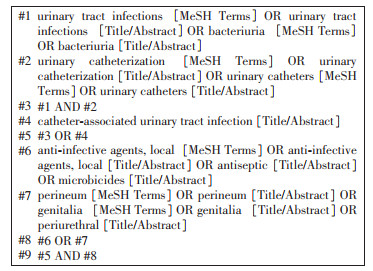 |
| 图 1 置管前尿道口消毒预防CAUTI Meta分析的PubMed检索策略 Figure 1 PubMed retrieval strategy for Meta-analysis on disinfection in urethral orifice to prevent CAUTI before catheterization |
根据PICOS原则制定。纳入标准:(1)P(研究对象):进行留置导尿管操作的患者,本次留置导尿管之前未发生尿路感染。(2)I(干预措施):试验组(消毒),即留置导尿管前使用消毒剂擦拭患者尿道口。(3)C(对照措施):对照组(清洁),即留置导尿管前使用清水或生理盐水擦拭患者尿道口。(4)O(结局指标):CAUTI发病率,包括有症状尿路感染和无症状菌尿症。(5)S(研究设计方案/类型):尿道口消毒与CAUTI发病率相关的RCT研究。排除标准:(1)非RCT的研究类型:个案报道、综述、评述等;(2)重复发表的文献;(3)结局数据不完整或统计指标不一致。
1.3 文献筛选与数据提取由2名研究人员各自筛选文献并提取归纳资料,若出现分歧,则相互讨论解决,仍无法达成一致的,请第三方裁定。文献筛选流程见图 2。资料提取主要包含以下方面:(1)基本信息:题目、作者、国家等;(2)研究对象的基线特征:性别、年龄等;(3)干预措施和对照措施的实施方式;(4)有关评价偏倚风险的因素;(5)结局指标值。
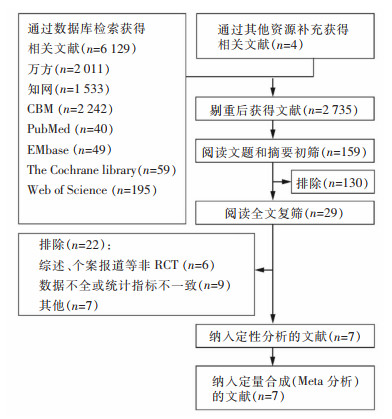 |
| 图 2 置管前尿道口消毒预防CAUTI Meta分析的文献筛选流程及结果 Figure 2 Literature screening process and result of Meta-analysis on disinfection in urethral orifice to prevent CAUTI before catheterization |
由2名研究人员各自评价纳入研究的偏倚风险,再对结果进行比对。用Jadad量表(改良)对纳入文献的方法学质量作评价。从纳入研究的随机分配方式、分配隐藏情况、盲法实施、退出与失访等角度进行评分,总分1~3分的视为低质量RCT,4~7分的视为高质量RCT。
1.5 统计学分析应用Stata 12.0软件进行Meta分析。发病率为二分类变量,采用比值比(odds ratio, OR)为效应统计量,均列出其95%置信区间(CI)。采用卡方检验评估各研究之间的统计学异质性(α=0.1),无论统计学异质性大小,考虑到未知的临床异质性和方法学异质性无法排除,本Meta分析使用随机效应模型(α=0.05)。若各研究结果存在明显的临床异质性,则采用亚组分析和敏感性分析进一步处理。发表偏倚采用Egger’s检验,并绘制漏斗图进行分析。使用GPower 3.1软件对纳入文献及总体进行效能分析(α=0.05)。
2 结果 2.1 文献检索结果初步检索共获得6 129篇文献,通过删除重复文献、阅读文献题目和摘要初步筛选文献,阅读全文再次筛选,最终纳入7篇RCT,均为英文文献。文献筛选流程及结果见图 2。
2.2 纳入文献基本特征纳入7篇RCT[19-25],来自英国[19]、土耳其[20]、中国香港[21]、澳大利亚[22, 24]、泰国[23]、伊朗[25]等6个国家/地区。共纳入留置导尿管患者3 030例,其中消毒组1 642例,清洁组1 388例。见表 1。
| 表 1 置管前尿道口消毒预防CAUTI Meta分析纳入文献的基本特征 Table 1 Basic characteristics of included literatures for Meta-analysis on disinfection in urethral orifice to prevent CAUTI |
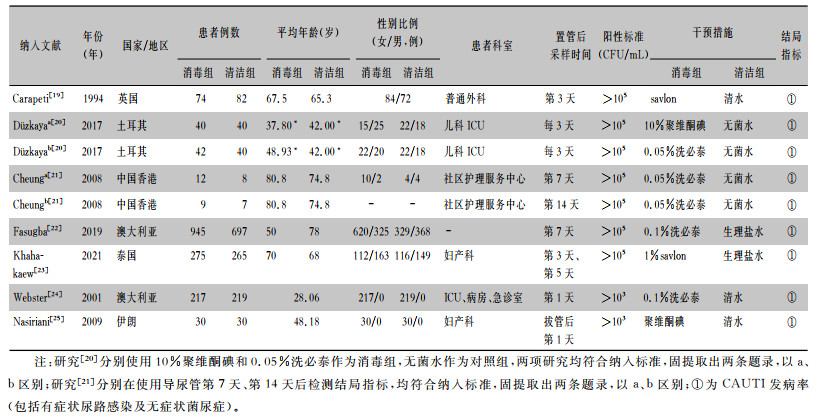
|
最终纳入的7篇文献中,5篇文献阐明了随机分配的方法,其余2篇文献阐明了RCT,但未说明随机分配的方法;2篇文献使用盲法,1篇文献明确说明未使用盲法,其余4篇未说明是否使用盲法;7篇文献均说明了纳入研究的对象,均未失访。根据Jadad改良量表的评分,总分≤3分的2篇,属于低质量RCT;其余5篇总分为4~6分,属于较高质量RCT。见表 2。
| 表 2 置管前尿道口消毒预防CAUTI Meta分析纳入文献的质量评价结果(分) Table 2 Quality evaluation result of included literatures for Meta-analysis on disinfection in urethral orifice to prevent CAUTI (Points) |
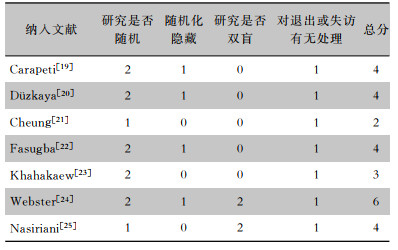
|
对7篇文献(9组试验)中的3 030例患者进行Meta分析,结果显示消毒组CAUTI发病率为6.21%(102/1 642),清洁组CAUTI发病率为8.21%(114/1 388)。各研究间统计学异质性较低(I2 = 6.6%),但由于临床异质性、方法学异质性的存在不可忽略,采用随机效应模型。Meta分析显示消毒组和清洁组CAUTI发病率比较,差异无统计学意义[OR=0.78,95%CI(0.57~1.08),P=0.380],见图 3。
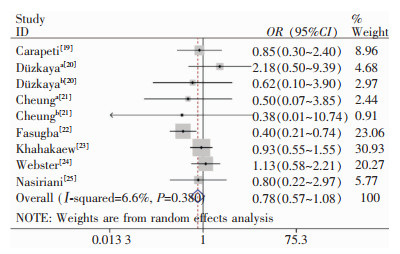 |
| 图 3 消毒组与清洁组CAUTI发病率Meta分析结果 Figure 3 Meta-analysis result of incidence of CAUTI in di-sinfection group and cleaning group |
根据改良版Jadad量表评分,将质量较低的RCT(Cheung等[21]的研究)剔除后进行Meta分析,结果显示消毒组CAUTI发病率为5.42%(88/1 623),清洁组CAUTI发病率为7.36%(101/1 373),Meta分析显示消毒组和清洁组CAUTI发病率比较,差异仍无统计学意义[OR=0.81,95%CI(0.55~1.19),P=0.225],Cheung等[21]的研究对总效应量的影响不大,见图 4。
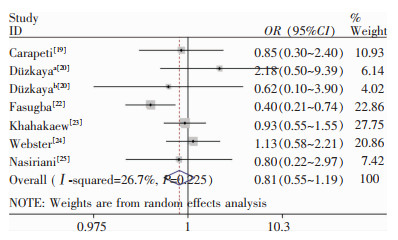 |
| 图 4 消毒组与清洁组CAUTI发病率Meta分析结果(高质量研究) Figure 4 Meta-analysis result of incidence of CAUTI in di-sinfection group and cleaning group(high quality RCT) |
根据研究对象来源国家/地区的人类发展指数(human development index,HDI) 将研究分为0.8≤HDI<1国家/地区[19-22, 24]和0.7≤HDI<0.8国家/地区[23, 25]的亚组。其中0.8≤HDI<1亚组各研究间统计学异质性较小(I2=24.4%),Meta分析显示消毒组和清洁组CAUTI发病率比较,差异无统计学意义[OR=0.75,95%CI(0.46~1.22),P=0.243];0.7≤HDI<0.8亚组各研究间无统计学异质性(I2=0),Meta分析显示消毒组和清洁组CAUTI发病率比较,差异无统计学意义[OR=0.91,95%CI(0.56~1.47),P=0.839]。见图 5。
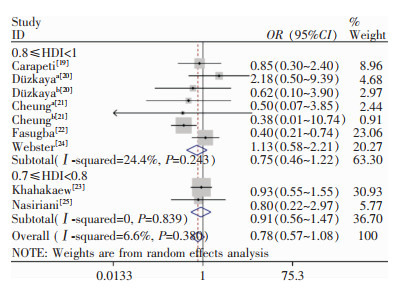 |
| 图 5 清洁组与消毒组CAUTI发病率各HDI亚组Meta分析结果 Figure 5 Meta-analysis result of incidence of CAUTI in each HDI subgroups of disinfection group and cleaning group |
根据CAUTI诊断标准中尿培养菌落数不同,将研究分为菌落数>105 CFU/mL[19-23]和菌落数>103 CFU/mL[24-25]的亚组。其中CAUTI诊断标准为菌落数>105 CFU/mL的亚组各研究间统计学异质性较小(I2=14.9%),Meta分析显示消毒组和清洁组CAUTI发病率比较,差异无统计学意义[OR=0.71,95%CI(0.47~1.08),P=0.316];其中CAUTI诊断标准为菌落数>103 CFU/mL的亚组各研究间无统计学异质性(I2=0),Meta分析显示消毒组和清洁组CAUTI发病率比较,差异无统计学意义[OR=1.06,95%CI(0.58,1.91),P=0.642]。见图 6。
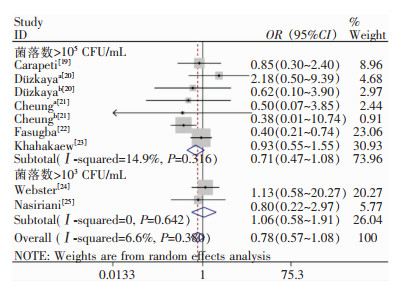 |
| 图 6 清洁组与消毒组CAUTI发病率各CAUTI诊断标准亚组Meta分析结果 Figure 6 Meta-analysis result of incidence of CAUTI in each CAUTI diagnostic criteria subgroup of di-sinfection group and cleaning group |
对纳入研究的7篇文献(9组试验)逐一进行剔除,敏感性分析结果表明,任意排除其中的一篇研究后,OR值与总合并效应值相似,P值均≥0.05,研究结果无明显性变化,提示本研究结果稳定可信。见表 3。
| 表 3 各研究消毒组与清洁组发生CAUTI敏感性分析结果 Table 3 Sensitivity analysis result of incidence of CAUTI in disinfection group and cleaning group in each inclu-ded literature |
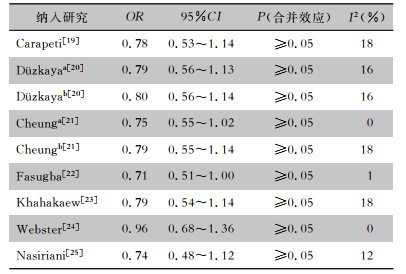
|
关于CAUTI发病率的各项研究基本对称分布于漏斗图两侧,Egger’s检验(t=0,P=0.996)提示无明显发表偏倚。见图 7。
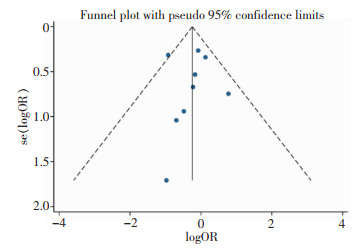 |
| 图 7 消毒组与清洁组CAUTI发病率的漏斗图 Figure 7 Funnel plots of incidence of CAUTI in disinfection group and cleaning group |
按照α=0.05的水平,对纳入文献及总体进行效能分析,各纳入研究的统计效能(1-β)为0.14%~84.55%,总体统计效能为55.49%。见表 4。
| 表 4 置管前尿道口消毒预防CAUTI Meta分析的纳入文献的统计效能分析 Table 4 Statistical efficacy analysis of Meta-analysis on included literatures about antiseptic efficacy in urethral orifice to prevent CAUTI before catheterization |
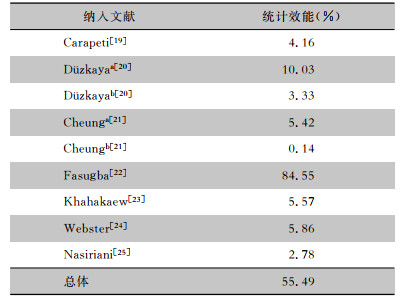
|
CAUTI作为医院感染的重要类型,既影响患者的生命质量,又延长患者的住院时长,还加重患者的经济负担。我国综合ICU的CAUTI发病率位于美国国家健康安全网络数据的P50~P75[26],提示我国CAUTI发病率仍有下降空间。采用合理的预防措施可减少17%~69%的CAUTI[14],为有效降低CAUTI发病率,应制定全面、科学、有效的CAUTI防控策略。随着我国经济发展水平的不断提高,我国医疗护理质量、医疗环境也不断优化和改善,各类医院感染防控策略应针对我国国情做出更新,尤其对存在争议的环节应进一步验证。
已有研究[27-28]表明,在留置导尿管后医务人员护理患者尿道口周围时,使用氯己定、碘伏等消毒剂与使用生理盐水、无菌水,对CAUTI的发病率无影响。此外,由于尿道口皮肤黏膜薄,使用消毒剂会对患者产生刺激,使患者舒适度和满意度降低[29]。并且,不必要的常规使用消毒剂,可能会导致菌群失调,甚至多重耐药菌的产生,增加治疗难度。因此各国指南对留置导尿管后患者尿道口的日常护理以清洁为主这一观点已达成共识。但针对留置导尿管前是进行尿道口清洁还是消毒这一操作步骤,各国指南或专家共识意见不统一。我国指南[15]虽然规定留置导尿管前应进行尿道口消毒,但仍有临床工作者及专家共识[16]对该步骤存疑。本文特别针对留置导尿管前尿道口周围消毒与清洁对CAUTI发病率影响的差异进行Meta分析,得出结果:置管前进行尿道口消毒与仅进行尿道口清洁对CAUTI发病率没有影响。仅需要使用生理盐水、无菌水或清水彻底清洁尿道口,既可减轻患者痛苦,又可降低医疗成本,进一步简化操作步骤。
我国CAUTI诊断标准中的尿培养阳性为菌落数>105 CFU/mL,与纳入文献中大多数CAUTI的标准一致,另有两篇文献尿培养阳性标准为菌落数>103 CFU/mL,为缩小诊断标准差异带来的异质性,本文根据尿培养阳性标准不同进行亚组分析,结果显示各亚组置管前尿道口消毒均不能达到预防CAUTI的目的。
由于各国家(地区)发展水平不同,医疗环境、医疗水平、医院感染防控能力等存在差距,可能导致不同国家医院感染防控指南在操作细节处存在差别。为缩小国家/地区发展水平差距带来的异质性,本文根据HDI进行亚组分析。HDI由联合国开发计划署创立,用以衡量各个国家与地区的发展水平,按HDI将国家发展水平划分为4个等级:极高(0.8≤HDI<1)、高(0.7≤HDI<0.8)、中(0.55≤HDI<0.7)、低(HDI<0.55)。大多数极高HDI国家为欧美国家,我国2020年HDI值为0.761[30],属于高HDI国家。本系统研究纳入文献来自4个极高HDI国家/地区、2个高HDI国家,结果显示两组国家/地区置管前尿道口消毒均不能降低CAUTI发病率。但由于本研究纳入的高HDI(与我国国情接近)国家文献较少,可能无法直接反映我国医疗环境下置管前尿道口消毒对预防CAUTI的作用。
为了评估拒绝原假设(H0)的正确率,本文加做了统计效能分析。为了防止第一类错误,α通常被设置为0.05,而为了防止第二类错误,β常被设置为0.20[31-33]。因此,1-β必须>80%。在Meta分析中,总体1-β<80%。因此,本Meta分析并未提供充分的证据证明留置导尿管前尿道口清洁或消毒对于预防CAUTI的效率一致,还需要更高水平的研究。
综上所述,留置导尿管时,尿道口消毒与尿道口清洁相比,预防CAUTI的效果未见差异,此研究结果可能与目前国内指南相矛盾,但受纳入文献数量、质量、地区等限制,为了制定更科学、更符合我国国情的CAUTI预防策略,尚需进一步开展我国医疗背景下的大样本、高质量的临床研究,以提供循证依据。
利益冲突:所有作者均声明不存在利益冲突。
| [1] |
Allegranzi B, Bagheri Nejad S, Combescure C, et al. Burden of endemic health-care-associated infection in developing countries: systematic review and Meta-analysis[J]. Lancet, 2011, 377(9761): 228-241. DOI:10.1016/S0140-6736(10)61458-4 |
| [2] |
程乔, 李武平, 闫沛, 等. 医院获得性尿路感染风险预警评分模型的构建[J]. 现代预防医学, 2019, 46(9): 1616-1623, 1649. Cheng Q, Li WP, Yan P, et al. Construction of risk early-warning model of hospital-acquired urinary tract infection[J]. Modern Preventive Medicine, 2019, 46(9): 1616-1623, 1649. |
| [3] |
Magill SS, Edwards JR, Bamberg W, et al. Multistate point-prevalence survey of health care-associated infections[J]. N Engl J Med, 2014, 370(13): 1198-1208. DOI:10.1056/NEJMoa1306801 |
| [4] |
王力红, 吴安华, 安友仲, 等. 重症监护病房医院感染预防与控制规范WS/T 509—2016[J]. 中国感染控制杂志, 2017, 16(2): 191-194. Wang LH, Wu AH, An YZ, et al. Regulation for prevention and control of healthcare associated infection in intensive care unit[J]. Chinese Journal of Infection Control, 2017, 16(2): 191-194. |
| [5] |
Richards MJ, Edwards JR, Culver DH, et al. Nosocomial infections in combined medical-surgical intensive care units in the United States[J]. Infect Control Hosp Epidemiol, 2000, 21(8): 510-515. DOI:10.1086/501795 |
| [6] |
李飞, 邓波, 朱世琴, 等. 住院患者导尿管相关尿路感染危险因素的Meta分析[J]. 中国感染控制杂志, 2018, 17(9): 770-776. Li F, Deng B, Zhu SQ, et al. Risk factors for catheter-associa- ted urinary tract infection in hospitalized patients: a Meta ana-lysis[J]. Chinese Journal of Infection Control, 2018, 17(9): 770-776. DOI:10.3969/j.issn.1671-9638.2018.09.004 |
| [7] |
马新利, 马德春, 丁璐, 等. 重症监护病房留置导尿管患者泌尿道感染的危险因素及病原体分析[J]. 中国感染控制杂志, 2016, 15(8): 615-617. Ma XL, Ma DC, Ding L, et al. Risk factors and pathogens of urinary tract infection in intensive care unit patients with indwelling urinary catheters[J]. Chinese Journal of Infection Control, 2016, 15(8): 615-617. DOI:10.3969/j.issn.1671-9638.2016.08.019 |
| [8] |
Hollenbeak CS, Schilling AL. The attributable cost of catheter-associated urinary tract infections in the United States: a systematic review[J]. Am J Infect Control, 2018, 46(7): 751-757. DOI:10.1016/j.ajic.2018.01.015 |
| [9] |
Wong ES. Guideline for prevention of catheter-associated urinary tract infections[J]. Am J Infect Control, 1983, 11(1): 28-36. DOI:10.1016/S0196-6553(83)80012-1 |
| [10] |
Pratt RJ, Pellowe C, Loveday HP, et al. The epic project: developing national evidence-based guidelines for preventing healthcare associated infections. Phase I: Guidelines for preventing hospital-acquired infections. Department of Health (England)[J]. J Hosp Infect, 2001, 47(Suppl): S3-S82. |
| [11] |
Pratt RJ, Pellowe CM, Wilson JA, et al. epic2: national evidence-based guidelines for preventing healthcare-associated infections in NHS hospitals in England[J]. J Hosp Infect, 2007, 65(Suppl 1): S1-S64. |
| [12] |
Loveday HP, Wilson JA, Pratt RJ, et al. epic3: national evidence-based guidelines for preventing healthcare-associated infections in NHS hospitals in England[J]. J Hosp Infect, 2014, 86(Suppl 1): S1-S70. |
| [13] |
Lo E, Nicolle LE, Coffin SE, et al. Strategies to prevent cathe- ter-associated urinary tract infections in acute care hospitals: 2014 update[J]. Infect Control Hosp Epidemiol, 2014, 35(5): 464-479. DOI:10.1086/675718 |
| [14] |
Gould CV, Umscheid CA, Agarwal RK, et al. Guideline for prevention of catheter-associated urinary tract infections 2009[J]. Infect Control Hosp Epidemiol, 2010, 31(4): 319-326. DOI:10.1086/651091 |
| [15] |
中华医学会. 临床技术操作规范护理分册[M]. 北京: 人民军医出版社, 2005. Chinese Medical Association. Clinical technical practice stan-dard-nursing volume[M]. Beijing: People's Military Medical Press, 2005. |
| [16] |
蔡虻, 高凤莉. 导管相关感染防控最佳护理实践专家共识[M]. 北京: 人民卫生出版社, 2018. Cai M, Gao FL. Best nursing practices in the prevention and control of catheter-related infections[M]. Beijing: People's Medical Publishing House, 2018. |
| [17] |
Fasugba O, Koerner J, Mitchell BG, et al. Systematic review and Meta-analysis of the effectiveness of antiseptic agents for meatal cleaning in the prevention of catheter-associated urinary tract infections[J]. J Hosp Infect, 2017, 95(3): 233-242. DOI:10.1016/j.jhin.2016.10.025 |
| [18] |
孟鑫, 柳宁, 刘琴. 我国碘伏预防导尿管相关尿路感染的Meta分析[J]. 中国消毒学杂志, 2021, 38(4): 262-265, 268. Meng X, Liu N, Liu Q. A Meta-analysis on iodophor of preventing catheter-associated urinary tract infections in China[J]. Chinese Journal of Disinfection, 2021, 38(4): 262-265, 268. |
| [19] |
Carapeti EA, Andrews SM, Bentley PG. Randomised study of sterile versus non-sterile urethral catheterisation[J]. Ann R Coll Surg Engl, 1996, 78(1): 59-60. |
| [20] |
Düzkaya DS, Uysal G, Bozkurt G, et al. Povidone-iodine, 0.05% chlorhexidine gluconate, or water for periurethral cleaning before indwelling urinary catheterization in a pediatric intensive care: a randomized controlled trial[J]. J Wound Ostomy Continence Nurs, 2017, 44(1): 84-88. DOI:10.1097/WON.0000000000000280 |
| [21] |
Cheung K, Leung P, Wong YC, et al. Water versus antiseptic periurethral cleansing before catheterization among home care patients: a randomized controlled trial[J]. Am J Infect Control, 2008, 36(5): 375-380. DOI:10.1016/j.ajic.2007.03.004 |
| [22] |
Fasugba O, Cheng AC, Gregory V, et al. Chlorhexidine for meatal cleaning in reducing catheter-associated urinary tract infections: a multicentre stepped-wedge randomised controlled trial[J]. Lancet Infect Dis, 2019, 19(6): 611-619. DOI:10.1016/S1473-3099(18)30736-9 |
| [23] |
Khahakaew S, Suwanpimolkul G, Wongkeskij T, et al. A comparison of the efficacy of normal saline and Savlon solutions in periurethral cleaning to reduce catheter-associated bacteriuria: a randomized control trial[J]. Int J Infect Dis, 2021, 105: 702-708. DOI:10.1016/j.ijid.2021.02.086 |
| [24] |
Webster J, Hood RH, Burridge CA, et al. Water or antiseptic for periurethral cleaning before urinary catheterization: a randomized controlled trial[J]. Am J Infect Control, 2001, 29(6): 389-394. DOI:10.1067/mic.2001.117447 |
| [25] |
Nasiriani K, Kalani Z, Farnia F, et al. Comparison of the effect of water vs. povidone-iodine solution for periurethral cleaning in women requiring an indwelling catheter prior to gynecologic surgery[J]. Urol Nurs, 2009, 29(2): 118-121, 131. |
| [26] |
李六亿, 李洪山, 郭燕红, 等. 加强医院感染防控能力建设, 提升医院感染管理水平[J]. 中国感染控制杂志, 2015, 14(8): 507-512. Li LY, Li HS, Guo YH, et al. Strengthening competence building for preventing and controlling health-care-associated infection, improving healthcare-associated infection management level[J]. Chinese Journal of Infection Control, 2015, 14(8): 507-512. DOI:10.3969/j.issn.1671-9638.2015.08.002 |
| [27] |
韩玲样, 孙庆芬, 曹煜隆. 尿道口清洁消毒方法预防导尿管相关尿路感染效果的贝叶斯网状Meta分析[J]. 中国消毒学杂志, 2018, 35(9): 659-662. Han LY, Sun QF, Cao YL. Network Meta-analysis of the effectiveness of antiseptic agents for urethral orifice cleaning in the prevention of catheter-associated urinary tract infections[J]. Chinese Journal of Disinfection, 2018, 35(9): 659-662. DOI:10.11726/j.issn.1001-7658.2018.09.007 |
| [28] |
徐波, 王惠, 高绪芳. 留置尿管病人尿道口消毒与清洁护理的效果比较[J]. 中华护理杂志, 2006, 41(11): 1044-1045. Xu B, Wang H, Gao XF. Comparative study on the effects of daily meatal cleansing with hibitane solution and boiled water for patients with indwelling urinary catheter[J]. Chinese Journal of Nursing, 2006, 41(11): 1044-1045. DOI:10.3321/j.issn:0254-1769.2006.11.034 |
| [29] |
宋树坤, 王凤红, 侯慧卿, 等. 留置导尿期间尿道口护理方法与尿路感染的相关研究及患者舒适度和满意度评价分析[J]. 河北医药, 2015, 37(16): 2542-2544. Song SK, Wang FH, Hou HQ, et al. Study on nursing metho- ds of urethral orifice and urinary tract infection during in-dwelling catheterization and evaluation of patient comfort and satisfaction[J]. Hebei Medical Journal, 2015, 37(16): 2542-2544. |
| [30] |
United Nations Development Programme. Human develop ment reports[EB/OL]. [2021-09-01]. https://hdr.undp.org/en/data.
|
| [31] |
Wang D, Zhai JX, Zhang LM, et al. Null genotype of GSTT1 contributes to increased Parkinson's disease risk in Caucasians: evidence from a Meta-analysis[J]. Mol Biol Rep, 2014, 41(11): 7423-7430. DOI:10.1007/s11033-014-3631-6 |
| [32] |
Mizuguchi T, Kawamoto M, Meguro M, et al. Laparoscopic hepatectomy: a systematic review, Meta-analysis, and power analysis[J]. Surg Today, 2011, 41(1): 39-47. DOI:10.1007/s00595-010-4337-6 |
| [33] |
Jia ZW, Chen C, Wu YH, et al. No difference in clinical outcomes after total knee arthroplasty between patellar eversion and non-eversion[J]. Knee Surg Sports Traumatol Arthrosc, 2016, 24(1): 141-147. DOI:10.1007/s00167-014-3351-4 |



